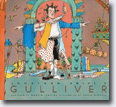 
|
The narrative and the illustrations complement each other perfectly. As the words crackle out of the pages, the pictures capture every nuance and expression of both Gulliver and his myriad hosts. Jonathan Swift’s tale of the many adventures of the intrepid doctor and traveler, Lemuel Gulliver, has enchanted generations of readers. Who among us has not heard of the feisty Lilliputs, the undersized people who are at war with the people of Blefuscu? Or of the gentle giants of Brobdingnag?
Martin Jenkins introduces the tale to a new generation of readers (aimed at the 9-12 age group) by making Swift’s cautionary tale more accessible. His descriptions are vivid and his attention to detail makes Gulliver’s adventures more believable. The writing is crisp and the focus is on keeping the action moving, as the following lines indicate:
“Struggling to get loose, I finally managed to free my left arm
and, by pulling violently, loosened the threads tying my hair down,
so that I could turn my head a little. I tried to grab a handful of the
tiny men, but they scurried off again, all yelling at once. Then one
of them cried, “Tolgo phonac,” and I was instantly bombarded with
hundreds of minute arrows, which pricked me like so many needles
and hurt terribly.”
Chris Riddell offers a one-two punch by providing dazzling illustrations that bring to life the scenes described in the narrative. The reader can empathize with Gulliver as his hair and body are tied to the ground, a sharp arrow pierces his nose and he is surrounded by hundreds of little people brandishing weapons. Gulliver’s bewilderment is indeed palpable!
Jenkins covers all of Gulliver’s travels. It includes the adventurer’s travel to Laputa, a country where its people are obsessed with music and math and where the king controls his subjects by literally floating over them.
Jenkins' narration of the impractical people of Laputa is at times laugh-out loud. Swift’s tongue-in-cheek description of the professor in Laputa who invents a machine that people can use to write books on any subject without having to know or understand anything is wonderfully recaptured in the book.
Then there is Gulliver’s visit to Houyhnhnms, a land where the horses are the civilized and sane inhabitants and the humans are the barbarians. Gulliver’s angst upon his return to England at the end of his sojourn in this island forms the beginning and the end of the book.
While younger readers may find this part of the narrative difficult to comprehend, older ones would find this to be a great introduction to the peccadilloes of humans. Swift’s wondrous imagination of lands where people are different is both enchanting and thought provoking.
Jenkins has captured all of the beauty in Swift’s tale, and coupled with
Riddell's illustrations, has made this a must-read for the young reader.
|







|